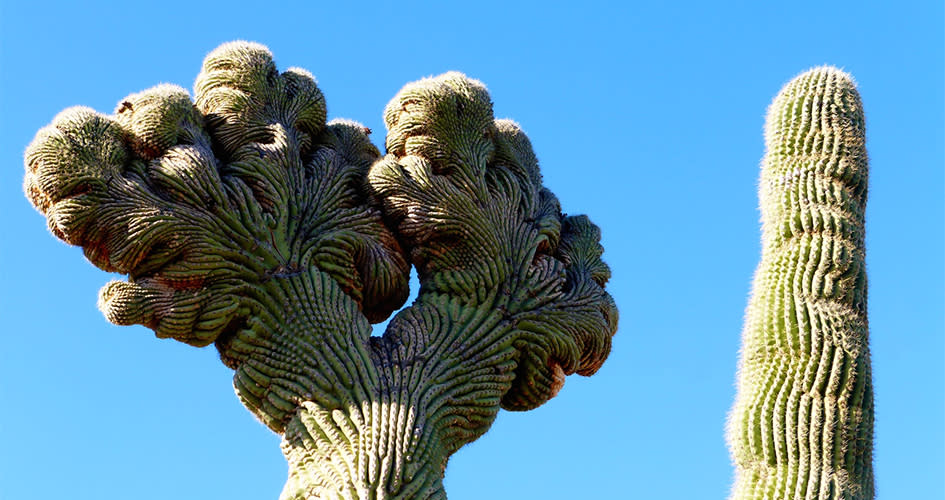Great slabs of boulders lay all around me, a variety of shapes and faces etched by erosion into their rough skin. I notice eyes peering at me, and world-weary grins. This, I thought, is where the Easter Island heads go to retire.
I’m hiking through Coyote Canyon, one of the newer trails in the far northern half of Scottsdale’s McDowell Sonoran Preserve. Although hiking is too strong of a word to use since it implies movement. I’ve ground to a halt in Coyote Canyon. I’m held captive by the distinctive features and devastating beauty of this rocky defile.
The Arizona desert is full of secret places, hidden away in a thin forest of cactus and yucca, mesquite and acacia. The only way to discover even a tiny fraction of them all is to get out and walk around. Coyote Canyon is one of those little gems, a narrow gorge toothy with boulders.
Getting to the Coyote Canyon Trailhead
Since Coyote Canyon is deep in the Preserve, it can only be reached from connecting trails. The closest access point is from the 136th Street and Dove Valley Road intersection. There’s no official trailhead parking but a slice of roadside space leaves room for two to three cars.
I start my hike on the wide Dove Valley Trail, an old 4X4 road. The rising bulk of Granite Mountain dominates the skyline. At 0.3 miles I intersect the Cowpoke Trail. This will be my return route. Soon Dove Valley dips into a low drainage and begins following a sandy wash. A mile from the trailhead, the Coyote Canyon Trail branches off to the left.
Almost immediately the trail takes on a different character as it enters the shallow canyon. Clustered boulders squeeze in around the path and granite walls rise above. Arizona's Coyote Canyon will never be mistaken for the Grand Canyon. It’s a sliver of a canyon, an arroyo with dreams. But that intimacy is part of its charm.

Hiking the Coyote Canyon Terrain
The narrow sandy path threads its way through a maze of granite. Some boulders seem neatly stacked; others are strewn about with abandon. Stone walls close in, forming a mini-slot canyon. I ooze through this section like wintertime molasses as I study the details of these close quarters.
Plenty of greenery grows among the stones, no doubt benefitting from the occasional flow of water through this natural channel. The desert doesn’t receive much rain but when it comes, it’s often in the form of sudden summer downpours. Grasses and shrubs fringe the Coyote Canyon trail along with a few scattered mesquite trees. I spot a fat barrel cactus growing from a crack in a rock.
After a few scenic twists and turns, the path corkscrews out of the shallow canyon amid a hearty stand of saguaros. The saguaro cactus is the defining plant of the Sonoran Desert, lean giants that grow as tall as office buildings. The real showstopper is just ahead, an unusual double crested saguaro grows right at the edge of the trail. When the growing tip of a saguaro produces a fan-like shape instead of columnar arms, it’s referred to as crested or cristate. Biologists aren’t sure what causes the abnormal growth but the curious plants are very cool to see.

The one along Coyote Canyon (located at the junction with the Desperado Trail) is especially rare because the main trunk has forked with both ends fanning out into a double crest. I do a lot of desert hiking and this is the only double crested cactus I’ve ever encountered. It’s like seeing a saguaro wearing Mickey Mouse ears.
How Long the Trail Runs
Coyote Canyon Trail (1.3 miles total) rambles across the desert for another half-mile or so before ending at Granite Mountain Trail. I turn left on the path as it skirts the base of the mountain. Granite is one of the handful of prominent peaks that punctuate the northern section of the McDowell Sonoran Preserve. Rough-hewn desert, open skies and plenty of hidden gems along the way—this is where folks go to slip away from crowds.
On the return, it’s a half-mile on Granite Mountain to the Cowpoke Trail, which I follow for another 0.6 miles back to Dove Valley. The complete loop is 3.7 miles. That’s a lot of diverse beauty crammed into just a short walk.
Providing a sudden burst of the spectacular, that’s what Scottsdale’s McDowell Sonoran Preserve does best of all.
Roger Naylor is an Arizona travel writer and author. His latest book is Arizona National Parks and Monuments: Scenic Wonders and Cultural Treasures of the Grand Canyon State. He is a member of the Arizona Tourism Hall of Fame and narrator of Verde Canyon Railroad. For more info, visit www.rogernaylor.com.





